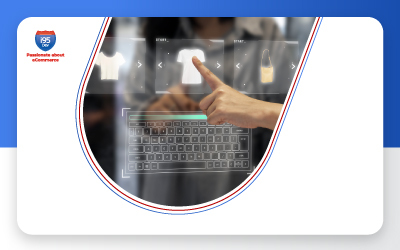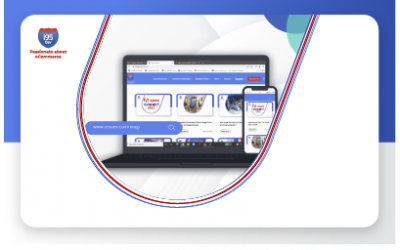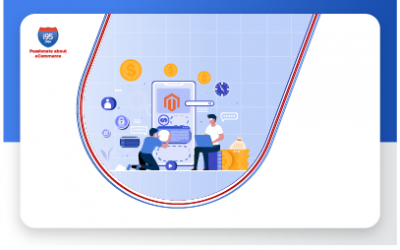December 14, 2021
Top 6 B2B eCommerce trends
to watch in 2022

The B2B eCommerce industry is expanding in leaps and bounds. In 2020, the global B2B eCommerce market size stood at $6.64 trillion and is anticipated to increase by 19.7% (CAGR) from 2021 to 2028. Most of the B2B companies are now engaging in eCommerce development to boost their sales and revenue generation.
Keeping up with the ever-changing customer demands is significant for all B2B businesses, and for that, it is imperative to stay relevant and grow with changing trends. In 2021, we witnessed multiple B2B eCommerce trends such as omnichannel selling, mobile-first websites, etc. The year 2022 is expected to take a step ahead in terms of B2B eCommerce. To decode the contemporary B2B buyers’ requirements, it is important for companies to be aware of the latest B2B eCommerce trends.
Here are the top 6 B2B eCommerce trends in 2022:
-
- Creating B2C-like experiences for B2B shoppers
There is a new generation of B2B buyers out there. These B2B buyers are looking more like B2C customers. There is no doubt that the number of B2B buyers who purchase products online is constantly increasing. It has been reported that B2B buyers carry out extensive research on a brand and its products before buying. Therefore, it is imperative for brands to build online stores that resonate well with B2B customers.
Since the wholesale customers are the same people who choose the online space for purchasing personal items as well, it becomes more than necessary to offer them a B2C-like shopping experience. Apart from professional B2B shoppers displaying B2C buying tendencies, studies show that by 2025, 75% of the global workforce will comprise digitally-minded millennials who will look for nothing but great online shopping experiences.
Thus, it is essential for companies to enhance user experience (UX) and user interface (UI) that makes it easy for B2B shoppers to find what they are searching for since most already know what they require.
-
- B2B mobile commerce is on the rise
According to Google and BCG, a seamless mobile experience for B2B eCommerce customers is a must in 2022:
-
-
- An average of more than 40% of the revenue earned by leading B2B companies comes from mobile commerce.
- Currently, more than 50% of B2B queries are made on smartphones/android phones.
-
Therefore, if you are running a B2B business online, you have no option but to make it mobile-friendly. Your company’s mobile customer experience needs to be up to the mark. According to statistical research, customers are 62% less likely to buy from a brand if the mobile customer experience wasn’t pleasant. Whether you want to create a downloadable mobile app or a responsive mobile website, a good mobile experience is essential in 2022.
-
- B2B customer personalization has never been so important
According to research reports and market analysts, 50% of B2B eCommerce buyers recognized enhanced personalization to be the most important feature when searching for eCommerce suppliers to build relationships with. In addition, the research stated that consumers were ready to shell out 48% more when their shopping experience was personalized.
According to another research report, the customer experience management market is anticipated to touch $14.9 billion by 2025, which means it will double itself. In simpler terms, if the brands want to stay in the competition, they should be well aware of the fact that B2B customers are looking for a B2C-like customer experience.
The million-dollar question is ‘How to personalize B2B buying experiences’?
To personalize B2B eCommerce shopping experiences completely, companies have to make efficient use of customer data, machine learning, and artificial intelligence (AI). For starters, B2B companies can focus on improving employee experience. Due to the current COVID-19 pandemic situation, a large number of employees are working remotely. You can empower your employees and help them provide excellent customer service by first offering them a good online work experience.
-
- Set a Direct-to-Consumer (DTC) channel afloat
B2B eCommerce brands are now accepting orders from customers directly. Most of the B2B online companies are worried about upsetting their distribution networks by opting for a DTC business model. They shouldn’t be as it is a profitable and positive shift!
With DTC, B2B eCommerce businesses can have better control over how their customers perceive their brand. In addition, they can make more profits since they have complete visibility of the customer base.
Selling DTC gives B2B companies control over the entire customer journey, from the time a customer lands on the eCommerce store until the delivery of the product and beyond. The Direct-to-consumer model helps B2B companies offer customer-centric experiences that can be generated out of first-hand data collection.
-
- Revenue optimization
According to Forrester, B2B customer retention rates range between 76 percent and 81 percent. Revenue optimization focuses on acquiring, retaining, and upselling customers. It helps you increase customer longevity and revenue from existing customers.
How to do it?
- Price optimization to ensure you are matching what your customers are willing to pay
- Profit optimization to maximize sales efficiency. Focus on the highest-quality leads to be able to maximize conversion rates.
- Optimize marketing efforts for better audience targeting.
- Inventory optimization to improve supply chain management.
- Systems Integration for Multi-Channel Selling
B2B eCommerce requirements are not easy to meet. An ERP integrated eCommerce ecosystem is needed to run the business efficiently. It is one of the most significant B2B eCommerce trends to watch in 2022 and beyond.
According to a research report, 57% of B2B executives have stated eCommerce integration as the top technology needed to carry out multi-channel selling successfully. Some of the B2B sellers choose third-party applications to manage finance, order fulfillment, and inventory. However, it is more than necessary to have a reliable integration provider on your team to efficiently tie those multiple systems together to seamlessly manage your online business and make higher profits.
Contact i95Dev for integrating your systems seamlessly!
Recent Blogs
B2B e-commerce – How Home Depot is leading the game
B2B eCommerce – How Home Depot is leading the game Author Category Share The home improvement industry has undergone a remarkable transformation, and at the heart of this change is the rise...
Accelerating Success: Best Practices for Automotive eCommerce
Accelerating Success: Best Practices for Automotive eCommerce Author Category Share In recent years, eCommerce has revolutionized the automotive sector, driving a notable surge in sales and...
Magento (Adobe Commerce) Pricing – Everything You Need To Know
Magento (Adobe Commerce) Pricing - Everything You Need To Know Author Category Share Adobe Commerce is a popular eCommerce platform used by many online stores to build and manage their...





